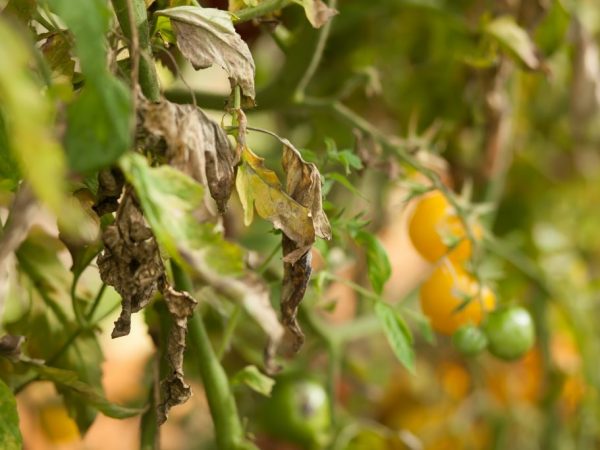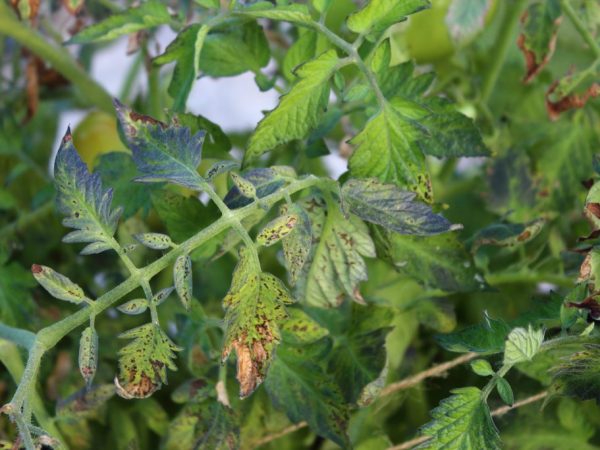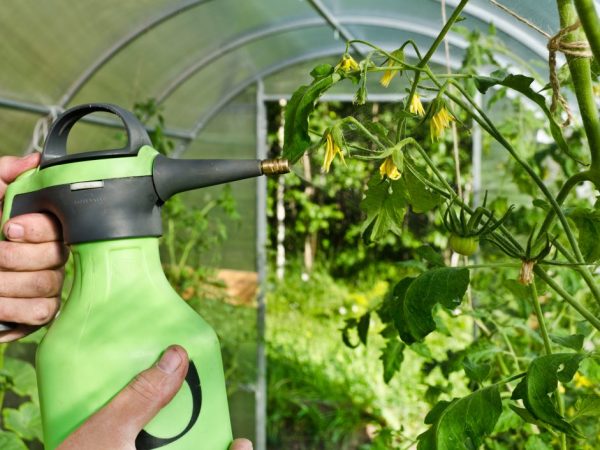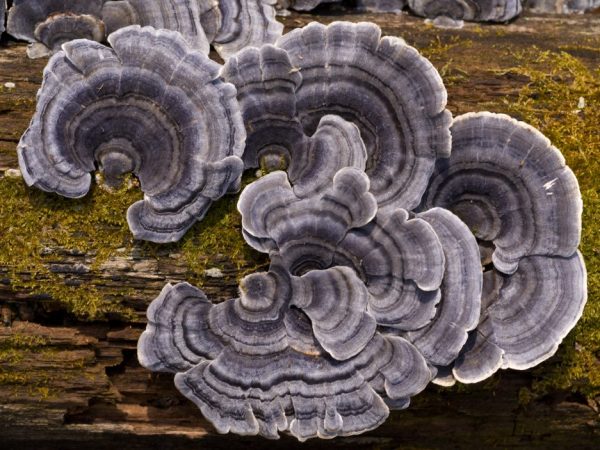Fighting late blight on tomatoes
Many gardeners who grow vegetable crops in their beds are often faced with such a plant disease as late blight on tomatoes. To fight this disease of vegetable crops is appropriate both with modern agrotechnical means and folk methods.
- About the nature of late blight
- Primary signs and contributing factors
- Agrotechnical methods of struggle
- Kitchen against late blight
- Kefir
- Yeast watering
- Garlic
- Salt
- Geology in the fight against late blight fungus
- Ash
- Copper wire
- Nature against tomato phytophthora
- Tinder
- Horsetail
- Straw
- Medicine against late blight
- Iodine solutions
- Boron
- Trichopolus

Fighting late blight on tomatoes
About the nature of late blight
The scientific name of late blight on fruits of tomatoes and other vegetable crops is late blight. Some gardeners who do not have much experience in combating plant diseases may have never come across such a name, and indeed they do not even know what phytophthora is. However, they could see strange black or brown spots on their vegetables. They look like foci and are present on the leaves of tomatoes and the surface of the fruits themselves, penetrating into the tissues and damaging the seeds. Phytophthora disease appears on infected tomato fruits when the leaves turn black, usually closer to the end of the gardening season, at the end of summer - before autumn. The harm from late blight lies in the inevitable death of tomato bushes, causing under its influence.
Without taking appropriate measures against late blight on tomatoes, you will have to come to terms with the loss of a significant part of the future tomato crop when harvesting a significant part of the future crop of tomatoes with damage to the inner tissue and seeds. Plucked off, affected by the fungus, the fruits are not eaten, their seeds cannot be used for subsequent planting, because they are destroyed. The collected surviving vegetables, removed before they are fully ripe, are sent to ripen.
The causative agent of phytophthora on tomatoes and other vegetation with them is the fungus of the same name. It inflicts the greatest destructive effect on the nightshade family, and among those most often falling under this unfavorable disease are tomatoes.
Primary signs and contributing factors
The main signs of late blight on tomatoes when infected:
- small foci of brown color on the tomato foliage on its back,
- the subsequent increase in the size of the phytophthora lesions of the plant and the amount of foliage and vegetables with them,
- drying out of tomato foliage and its fall,
- the acquisition of dark-colored tomato shoots,
- the appearance on the surface of vegetable fruits of foci of a dark gray shade, followed by their blackening.
Signs of tomato disease with late blight appear most often in the second half of the summer season. This is due, first of all, to the peculiarities of this calendar period, when there is a difference between day and night temperature regimes, when there is no full heating of the soil, how much is enough for drying out moisture.Under the influence of temperature fluctuations, abundant dew is formed on tomato bushes, which does not have time to dry due to a decrease in the overall air temperature, and becomes the most favorable environment for the appearance and development of late blight on tomatoes. Among the reasons why phytophthora appears on tomatoes:
- persistent rainy days and the early coolness that came with them,
- exceeding the norm of the lime component in the soil,
- excessive thickened planting of tomato bushes,
- lack of well-functioning air circulation in an enclosed space, because late blight often appears on tomatoes in a polycarbonate greenhouse,
from which the fungus begins to develop with them even better and at an accelerated pace.
The development of phytophthora in tomatoes slows down during the onset of heat and dry weather. With an increase in temperature conditions to sufficient indicators, you can completely get rid of it, since the fungal causative agent of late blight dies.
Agrotechnical methods of struggle

For prevention, use some techniques
Among the methods in the fight against late blight on tomatoes and for the prevention of late blight on tomatoes, experienced gardeners have long adapted to use a number of basic agricultural techniques to prevent disease and preserve vegetable crops and a sustainable future harvest. Good measures on how to deal with late blight on tomatoes and how to prevent late blight for tomatoes will be:
- observance of the basic rules of crop rotation, suggesting planting a vegetable crop after a change of place, adhering to a respite interval for the land of 3-4 years, and prohibiting the planting of tomato bushes in the land where potatoes, eggplants or peppers were previously grown, although the South Urals plants tomato seedlings after the potato harvest in the greenhouse and open soil, considering that the main thing is to warm up and loosen the soil correctly,
- reduction of watering tomatoes in excessively rainy and cloudy weather conditions, replacing this daily procedure with more frequent loosening of the soil, carefully passing between the rows of soil,
- restoration of a good acid balance of the soil in case of exceeding the norms of limestone, by introducing an additional portion of the peat component, in the process of planting tomato seedlings in open ground or a greenhouse, it is sprinkled on top with sand,
- correct distribution of the norm of planting density of tomato bushes, in accordance with the instructions for each individual tomato variety, avoiding their excessive thickening,
- conducting the main watering of a vegetable crop in the morning to ensure complete drying of moisture on fruits and foliage by the onset of the night period, in which there is a significant decrease in the temperature regime,
- the use of predominantly drip irrigation, avoiding the ingress of water on the foliage during irrigation.
In order to prevent the appearance of late blight on tomatoes, reviews of gardeners are recommended for growing in regions that are cool in summer climatic conditions, for example, in the Moscow region, to select and use those late blight-resistant varieties and hybrids that are highly resistant, are not afraid of late blight and are resistant to other fungal diseases.
To maintain tomato immunity throughout the gardening season, one must not forget to feed tomato bushes and treat them with immunomodulatory solutions.
In addition, agrotechnical methods of gardeners in the prevention of late blight on tomatoes include protecting the vegetable crop by covering it with a film or non-woven material. This should be done starting from the second half of the summer period, in the evening or during the period of prolonged rains. This will save your harvest from the unnecessary effects of morning dew and will protect against disease and the development of late blight.
Kitchen against late blight
Those gardeners who are skeptical about fungicides and other chemicals and preparations for processing vegetable crops in order to destroy fungal diseases with them, are trying to find for themselves the most effective way to save tomatoes from phytophthora. Among the ways how to spray tomatoes from late blight and how to protect tomatoes from late blight are well-known folk remedies that lead to a positive result and allow you to cure plants when they get sick.
Kefir
In order to carry out prophylaxis against late blight on tomatoes, many summer residents save sick seedlings and tomato bushes from danger in a greenhouse and in an open garden by means of a liter of fermented kefir or whey dissolved in a 10-liter bucket of water. In some cases, they add small amounts of granulated sugar to kefir. Such milk prevention of late blight is done on tomatoes and tomato bushes are processed from late blight on tomatoes weekly, and they begin to spray and wipe the bushes from the moment the ovary appears.
Yeast watering
Faced with the first signs of late blight on tomatoes, when the plants get sick, summer residents often try to defeat and prevent the development of a fungal disease by processing vegetables with simple baker's yeast. To do this, according to a simple recipe, fresh yeast (100 g) is dissolved in a liquid (10 liters of water) and then water the plantings of infected tomatoes with it. Some summer residents add mustard seeds to the yeast.
Garlic

Phytophthora fungus will disappear after spraying with a mixture of garlic
Spraying tomatoes from late blight with impurities containing garlic helps to stop and treat the disease late blight of tomatoes, leading, under the influence of garlic, to the death of late blight fungi. For spraying tomato bushes, make a tincture of 1.5 cups of finely chopped garlic heads and shoots and 10 liters of water. The garlic tincture is kept for a day, then filtered and 2 g of potassium permanganate is poured into it. It is recommended to spray tomato bushes with such a tincture at intervals of two weeks, or a little more often. The fight against late blight on tomatoes from garlic suggests an approximate consumption rate per bush of about half a liter.
Salt
Salt treatment is also a good remedy than treating tomatoes from late blight when the disease attacked. It is effective because salt forms a protective film on the foliage, which prevents phytophthora fungi from penetrating into the plant. Although this folk method is not intended for treatment, it is a good prevention for affected plants. It is possible to sprinkle food or sea salt dissolved in a bucket of water 250g at the stage when there is already an ovary. Before processing, before sprinkling on green leaves, damaged by late blight will first have to be removed and destroyed. Soda can be used with the same preventive effect.
Geology in the fight against late blight fungus
Considering folk remedies for late blight on tomatoes in the fight against late blight, gardeners often turn to natural ingredients. But we must not forget that different varieties of tomatoes react to spraying and are susceptible to processing by folk methods in their own way. The weather also plays an important role in the effectiveness and choice of folk remedies, how to protect tomatoes from late blight.
Ash
Among the popular folk remedies, how to deal with late blight and what to do with tomatoes in the prevention of late blight in tomatoes, simple ash received numerous positive reviews. Due to the content of many microelements, it acts as a full-fledged source of useful agents that help vegetable plants withstand tomatoes in the fight against late blight. The technology of preparation according to the most popular recipe for means with ash includes several stages:
- 5 liters of ash are dissolved in a 10 liter amount of water,
- the resulting mixture is thoroughly mixed and placed for 3 days for infusion, with periodic stirring,
- after the required time has elapsed, the infused solution with ash is brought to a 30-liter volume,
- soap is mixed into the solution (any is suitable for this purpose, however, the advice of experienced gardeners recommend an antibacterial household one), the purpose of the presence of soap in the ash solution is more effective adhesion of the solution to the leaves in order to save tomatoes from late blight in a short time.
The resulting folk remedy with ash is required to spray tomato bushes. At the same time, to treat the vegetable crop with ash, so that the treatment against fungal phytophthora on tomatoes is effective, it is recommended at least three times in one gardening season. The initial spraying falls on the planting of tomato seedlings in open ground or in a greenhouse, after 10 days. Re-processing of greenhouse tomatoes or in the open field from late blight falls on the stage of flowering of a vegetable crop. The third spraying, as a way to fight late blight on tomatoes, occurs after the appearance of ovaries.
Copper wire
Increasingly, reviews of summer residents are advised to use ordinary copper wire to combat and prevent late blight in tomatoes. They believe that copper particles contained in an industrial product are capable of neutralizing phytophthora fungi. For this folk remedy against fungal disease, cut the wire into pieces up to 3-4 cm long.Each of them will have to be ignited, cleaned, and subsequently inserted into the tomato stem closer to its lower part. The ends of the wire, in order to avoid injury when caring for the bushes, are bent towards the bottom, but do not twist around the stem, giving it freedom of growth and development. There are many videos of summer residents where you can see how to insert the wire correctly from late blight on tomatoes.
Nature against tomato phytophthora
Often, folk remedies for combating late blight in tomatoes basically contain the beneficial and protective properties of plants.
Tinder

Tinder fungus tincture will help fight disease
The tinder fungus acts as a good defender of vegetable crops against the appearance and development of fungal diseases of plants. Tinctures made on the basis of tinder fungus are intended for spraying tomato bushes. Their use makes it possible to increase the resistance of tomatoes to the destructive effects of late blight fungus, performing a protective function. The recipe for tincture with tinder fungus involves pouring 100 g of chopped tinder fungus with 1 liter of boiling water and insist until it cools. The tomato bushes are watered with a solution filtered through a bib or gauze. Tall plants should be tried to process from the very top to the bottom. The initial treatment falls on the stage of the appearance of ovaries, secondary spraying is done when the first signs of phytophthora appear on tomatoes.
Horsetail
Horsetail decoctions help to cope with late blight and grow stunted and tall, disease-prone tomatoes without fungus. Dry horsetail (100g) is boiled in a liter of water for half an hour - 40 minutes over low heat. The cooled broth is brought to a volume of 5 liters. Prepared horsetail broth is required to spray tomato bushes. Instead of dry horsetail, you can take fresh, then the rate per liter of water will be 150g.
Straw
A good means of preventing a fungal disease of tomatoes is a simple straw, on the basis of which a solution for watering or spraying is made. Rotten hay and fresh grass can be taken as the main organic component. They are poured with a bucket (10 l) of water with the addition of a handful of urea and infused for at least 4-5 days, after which they are filtered.
Medicine against late blight
In the fight and prevention against late blight on tomatoes, some summer residents often use chemistry, fungicides and medications, on the basis of which they make folk remedies. Common methods of treatment include iodine, potassium permanganate, furacilin, boron, trichopolum, metronidazole and other drugs.
In the list of ready-made preparations for late blight to save the harvest from late blight and phytosporosis, pharmacoid and profit and the well-known calcium chloride and Bordeaux mixture are better recommended. On the agrotechnical market, there is a contact copper-containing fungicide Hom, which has proven itself among chemical agents against fungus.
Iodine solutions
Iodine, which has antimicrobial properties, is often taken by gardeners for use in the fight against various microbes, including fungi. There are many recipes for preparing iodine mixtures for tomatoes:
- 9 liters of water will require a liter of low fat milk and 20 pipette drops of iodine,
- in 8 liters of water, you can dilute 2 liters of milk whey, 100 g of sugar, 15 pipette drops of iodine, instead of whey, you can use milk,
- 1 liter of milk whey with 40 pipette drops of iodine and a large spoonful of hydrogen peroxide is dissolved in a 10-liter bucket.
All solutions prepared on the basis of medical iodine are used for external treatment of infected green plants. With the help of iodine solutions, you need to process all the foliage and stems of tomato bushes. Particular attention is paid to the underside of the leaves.
Boron
Boric acid has established itself as a folk remedy, than you can spray tomatoes and thereby help them resist against the fungal disease late blight. When processing by spraying with boric acid, it is dissolved in a bucket of hot water in a proportion of 10 grams per 10 liters, adding 30 pipette drops of iodine there. In some cases, boric acid and iodine from phytophthora in an amount of 10 g of each component are added to a heated aqueous mixture of ash (8 liters per 2 liters).
In another recipe, potassium permanganate (at the tip of a knife) and copper sulfate from phytophthora, which must be diluted in a bucket of water, act as additional components to boric acid (10 g). Copper sulfate requires a small spoon. There, along with vitriol and potassium permanganate, it is recommended to put a small piece of laundry soap.
Trichopolus
Sometimes, in order to resist late blight on tomato fruits, gardeners resort to chemical medicines, among which trichopolum shows the best effect. You will need 10 tablets for a bucket of water. 15 ml of brilliant green is mixed with them. It is recommended to process the vegetable crops with the entire resulting mixture at the flowering stage and immediately at the first signs of phytophthora that has appeared.


